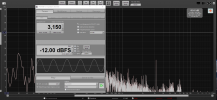restorer-john
Grand Contributor
My question is why you chose 1 uW@8 ohms?
1uW (2.83mV) into a typical 8R loudspeaker of 90dBSPL/1W@1M would produce a signal 1000 times (60dB) less, or 30dBSPL. That would be very close to the limit of even a quiet typical listening room. It's dead quiet in my house at the moment and I measure 33.9dB A in the listening area.
[email protected] into an 89dBSPL@1W/M loudspeaker (tested now) on my bench is just faintly audible at 1M. I'm talking disappearing into the residual noise. At 3M forget it.
Pick 4R and lower sensitivity and gets even worse...
A typical amplifier capable of the power output I described above, would have residual noise well into the double figures of millivolts and as such, could not audibly reproduce the full dynamic range of the CD format. i.e. at the low end, the signal will disappear into noise and at the top end, you run out of available voltage swing (power).



